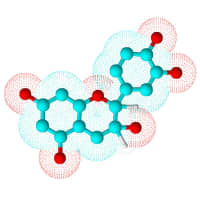Flavonoids are the most diverse group of phytochemicals.
Flavonoids are divided into six classes:
- Flavanols (flavan-3-ol)
- Flavanones
- Flavones
- Flavonols
- Isoflavonoids
- Anthocyanidins
Citrus Flavonoids
8-Prenylnaringenin (8-PN)
8-Prenylnaringenin is a phytoestrogen. It is reported to be the most estrogenic phytoestrogen known.
8-prenylnaringenin is a natural compound, structurally belonging to the group of prenylated flavonoids.
It is notable compound in Hops (Humulus lupulus L.), a key ingredient for beer brewing.
Due to its estrogenic effects, 8-PN represents a novel therapeutic approach to the treatment of menopausal and post-menopausal symptoms that occur as a consequence of a progressive decline in hormone levels in women.[1]
Application of 8-PN in the treatment of menopause has been clinically examined with promising results.[1:1]
Other activities that have already been assessed include the potential to prevent bone-resorption or inhibition of tumor growth.[1:2]
Cosmosiin
Diosmin
Didymin
Hesperetin
Hesperidin
Hesperidin is a flavanone glycoside found in citrus fruits. Hesperidin was first isolated from the white inner layer of citrus peels (mesocarp) in 1828. Hesperidin is believed to play a role in plant defense.Hesperidin is a flavanone glycoside found in citrus fruits. Hesperidin was first isolated from the white inner layer of citrus peels (mesocarp) in 1828. Hesperidin is believed to play a role in plant defense.Hesperidin is a flavanone glycoside found in citrus fruits. Hesperidin was first isolated from the white inner layer of citrus peels (mesocarp) in 1828. Hesperidin is believed to play a role in plant defense.
Natural Sources
- Citrus aurantium L. - Bitter Orange, Petitgrain
- Petitgrain is an essential oil that is extracted from the leaves and green twigs of the bitter orange tree via steam distillation. It is also known as petitgrain bigarade.
- Orange juice (Citrus sinensis)
- Zanthoxylum gilletii
- aka the East African satinwood, is a tree species in the genus Zanthoxylum found in Africa. The fruits are used to produce the spice uzazi.
- lemon
- lime
- leaves of Agathosma serratifolia
- Peppermint
- blood orange
- grapefruit
Isosinensetin
Naringenin
Naringin
Neohesperidin
Nobiletin
Poncirin
Quercetin
Rhoifolin
Rutin
Sinensetin
Sudachitin
Tangeretin
Xanthohumol
Title: Therapeutic Perspectives of 8-Prenylnaringenin, a Potent Phytoestrogen from Hops
Publication: MDPI Journal - Molecules
Date: March 2018
Study Type: Human: Case Review
Author(s): Kateřina Štulíková, Marcel Karabín, Jakub Nešpor, and Pavel Dostálek
Institution(s): Department of Biotechnology, University of Chemistry and Technology, Prague
Abstract: Hop (Humulus lupulus L.), as a key ingredient for beer brewing, is also a source of many biologically active molecules. A notable compound, 8-prenylnaringenin (8-PN), structurally belonging to the group of prenylated flavonoids, was shown to be a potent phytoestrogen, and thus, became the topic of active research. Here, we overview the pharmacological properties of 8-PN and its therapeutic opportunities. Due to its estrogenic effects, administration of 8-PN represents a novel therapeutic approach to the treatment of menopausal and post-menopausal symptoms that occur as a consequence of a progressive decline in hormone levels in women. Application of 8-PN in the treatment of menopause has been clinically examined with promising results. Other activities that have already been assessed include the potential to prevent bone-resorption or inhibition of tumor growth. On the other hand, the use of phytoestrogens is frequently questioned regarding possible adverse effects associated with long-term consumption. In conclusion, we emphasize the implications of using 8-PN in future treatments of menopausal and post-menopausal symptoms, including the need for precise evidence and further investigations to define the safety risks related to its therapeutic use.
Link ↩︎ ↩︎ ↩︎
